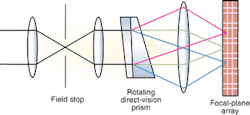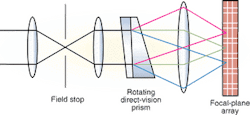Hyperspectral imagers target military uses
By detecting both spatial and spectral contents, hyperspectral imagers find widespread applications in earth resource management, military reconnaissance, and medical diagnostics. In military image-processing systems, the surveillance of transient events and moving objects mandates continuous data collection over the entire area of interest.
To meet this requirement, the sensor's optical throughput must be high and provide efficient mapping of the region being observed. At Solid State Scientific Corp. (SSSC; Nashua, NH, USA; www.solidstatescientific.com), a series of tomographic hyperspectral sensors have been developed that use off-the-shelf cameras to provide simultaneous wide-area coverage and wide spectral bandwidth.
"In principle," says James E. Murguia, president of SSSC, "tomographic sensors are capable of hyperspectral imaging surveillance of transient events and moving objects. However, the operation of tomographic sensors and the nature of tomographic signals are complex and require high-performance signal-reconstruction techniques."
Because the company's chromotomographic hyperspectral imaging sensor (CTHIS) uses a staring-mode, framing camera system that encodes both spatial and spectral information on every frame of data, the need for a slit, optical filter, or resonant cavity is eliminated. The design also removes the possibility that an event will occur when the sensor is viewing the wrong portion of the scene, or the wrong spectral band, at the wrong time. At present, SSSC offers three versions of the CTHIS: a visible to near-infrared (NIR) device, a mid-wavelength infrared (MWIR) version, and a long-wavelength infrared (LWIR) system with spectral ranges of 400 to 900 nm, 2.7 to 5 µm, and 6.5 to 11.5 µm, respectively. Originally developed in conjunction with the US Air Force Research Laboratory Sensors Directorate (Hanscom AFB, MA, USA; www.afrl.af.mil), all of the hyperspectral imagers are built using the same principles, with different cameras optimized for a specific band.
The SSSC design consists of a lens system coupled to a rotating direct-vision prism and a camera. During successive video frames, the prism is rotated, causing the image of spectral features to trace out circles with wavelength-dependent radii. Video frames are collected over a full prism rotation. This has the effect of multiplexing the spectral information of the image over the array, while, at the same time, the array is acting as a broadband imager. By using demultiplexing techniques similar to those used in computed-tomography scanners, the data cube of the spectral image can be computed.
Applications
Three SSSC multispectral imagers function across different wavelength bands. A visible/NIR hyperspectral imaging system is targeted toward crop management. In such applications, the imager would be aircraft-mounted to capture data at video rates over large areas. SSSC used a CAD-6 frame-transfer camera from Dalsa (Waterloo, ON, Canada; www.dalsa.com) to capture 256 × 256 images in 74 colors at 955 frames/s.
In its MWIR system, the company developed a proprietary sensor to detect 2.7- to 5-µm wavelengths, although such cameras are now available from companies such as FLIR Systems (N. Billerica, MA, USA; www.flir.com). Similarly, SSSC's LWIR imager uses a 256 × 256 HgCdTe sensor from Raytheon (Goleta, CA, USA; www.raytheon.com) that is embedded in a camera from SEIR (Goleta, CA, USA; www.seir.com).

